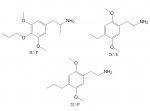ToxicFerret said:
Out of curiosity are there any other 3C-x chemicals that are known/suspected to be active?
Yeah, all the "3C"s are amphetamines, or
alpha-
methyl
phen
ethyl
amines. Amphetamines are alpha-methylated phenethylamines. There are many fantastic "3C" psychedelics.
DOB, DOC, DOET, DOI, DOM, DON, DOPR (DOP), DOT, DOT-2, DOT-7, FLEA, the FLY series, Ganesha, G-3, MDA, MDMA, MMDA, MMDA-2, some of the TOMs and TOETs sound ok. And I am sure I am missing a few. All are 3Cs.
Basically Shulgin started his psychedelic research by trying to make mescaline more powerful. He invented TMA. TMA and mescaline are the same except TMA has a methyl group (which has three carbons) at its alpha position, while mescaline has two. One could call TMA, "3C-mescaline." Or one could call TMA, "2C-TMA." Get it? The 2C, 3C refers to how many carbons are at the alpha position. The "2C" means two carbons at the alpha position, the "3C" means it has three carbons at the alpha.
Now as I was saying, Shulgin started his research with amphetamines (three carbons and the amine group) and made a bunch such as DOB, DOC, DOI, DOT, etc. Then later he decided to work on the phenethylamine "versions" of these materials. Amphetamines are phenethylamines with an extra carbon at the alpha...phenethylamines have a total of two carbons and then the amine.
So the "two carbon" version of DOB is 2C-B. The "two carbon" version of DOC is 2C-C. The "two carbon" version of DOI is 2C-I. The "three carbon" version of proscaline is 3C-P. The "three carbon" version of escaline is 3C-E. Etc, etc, etc.





